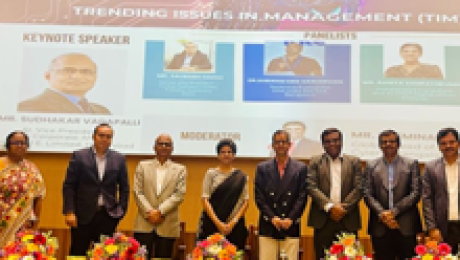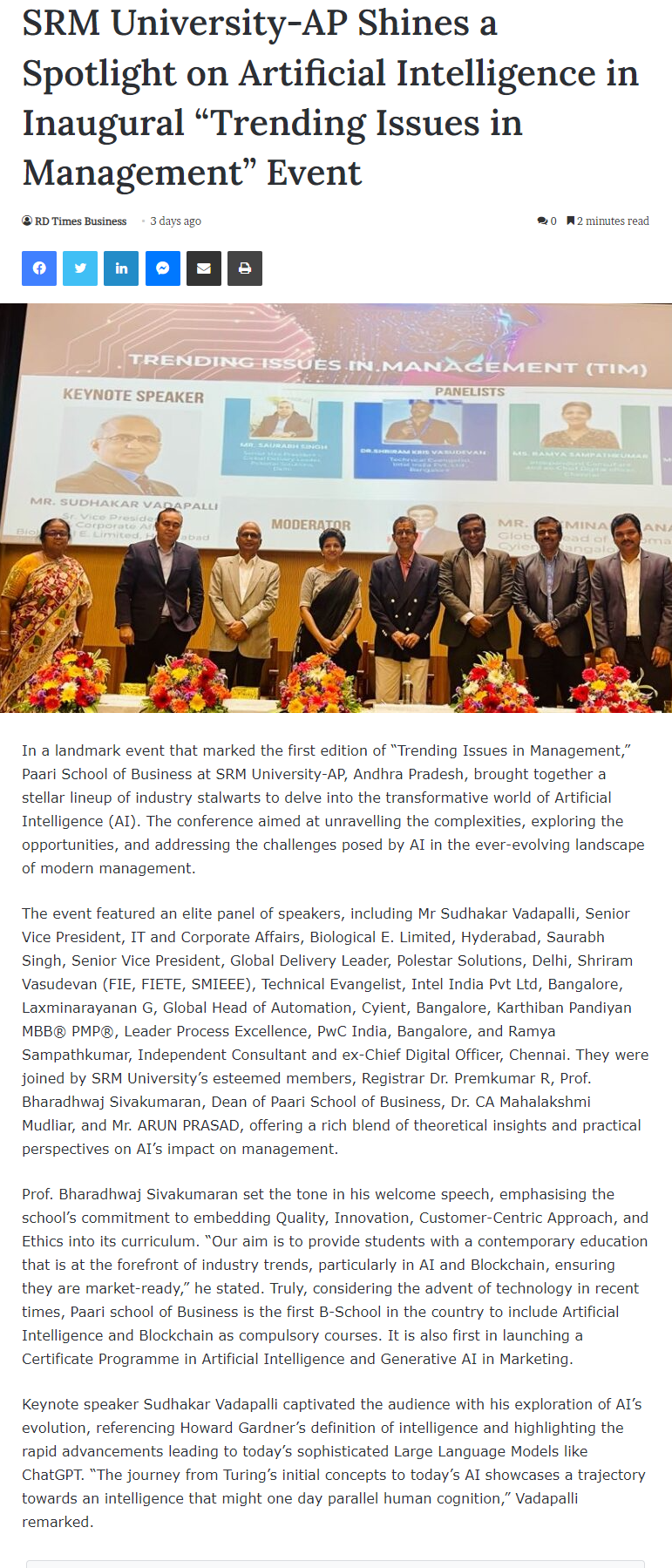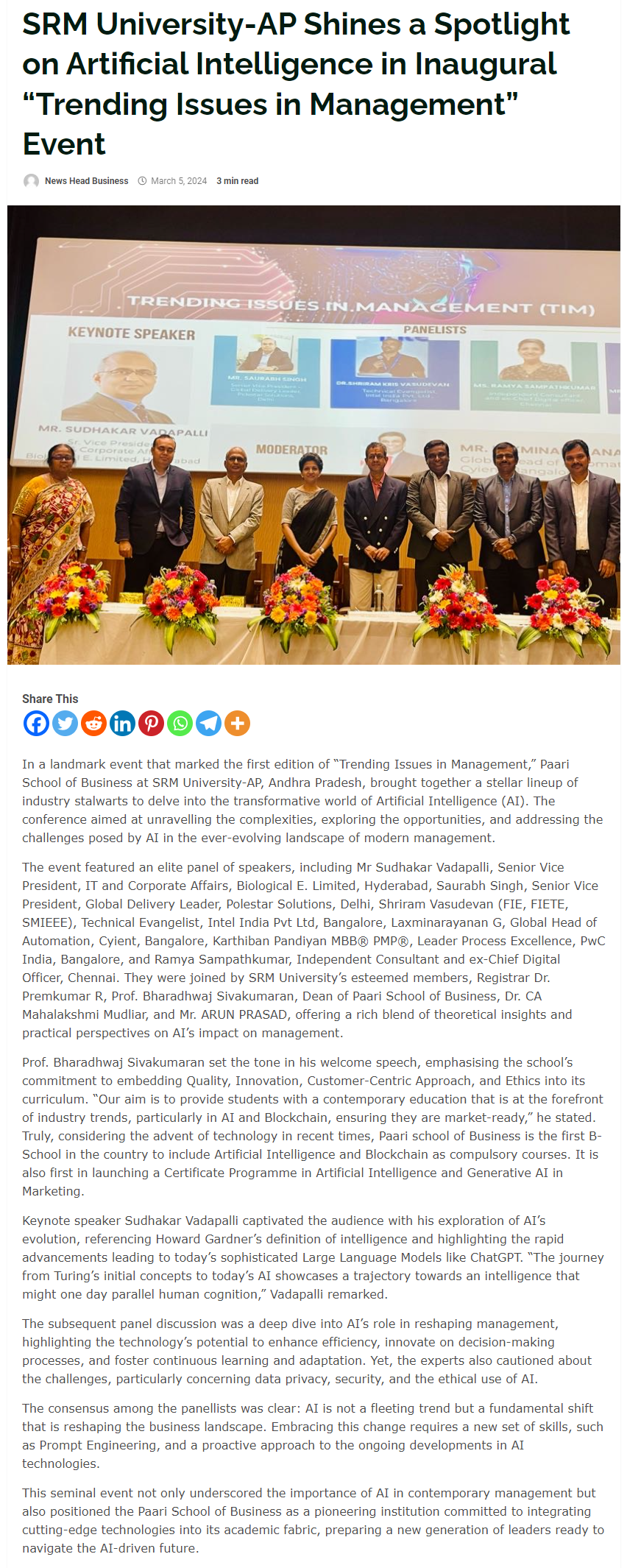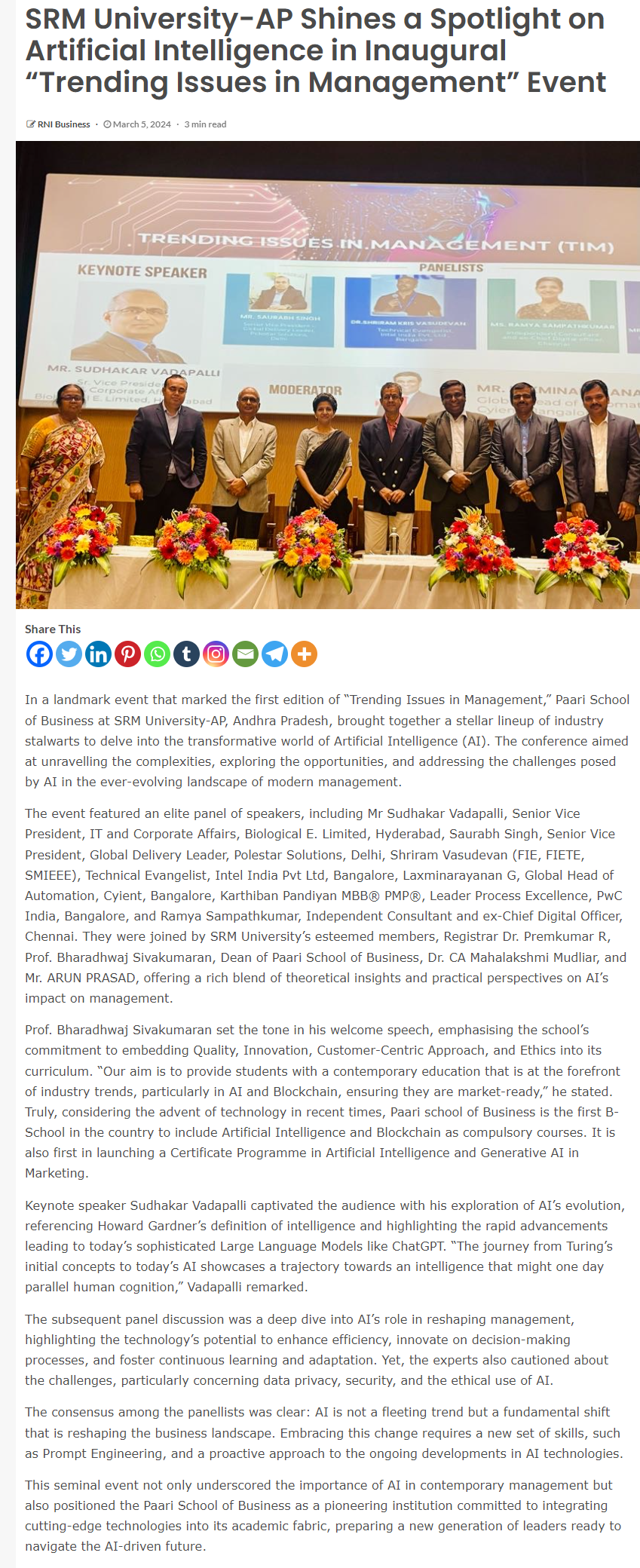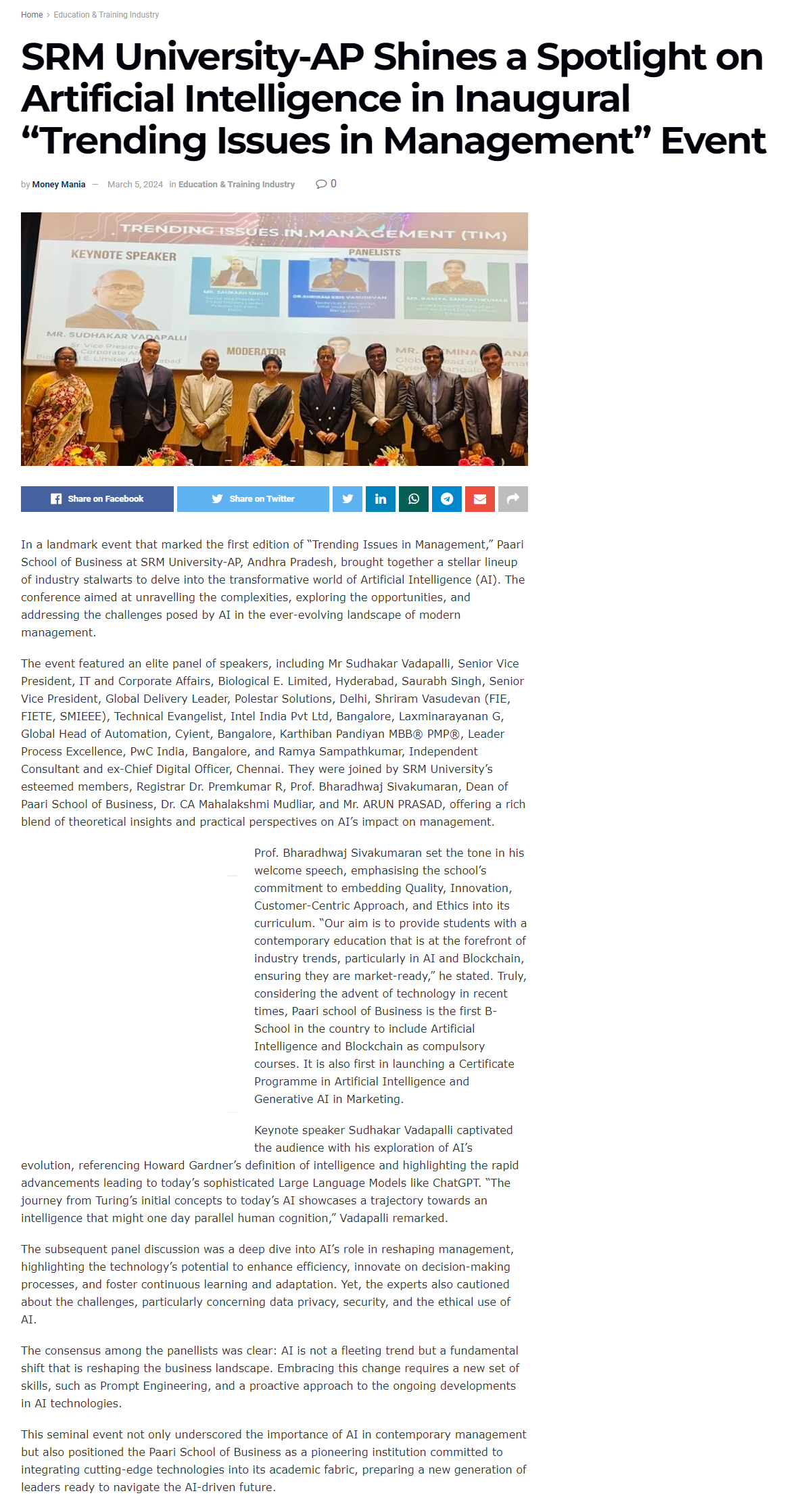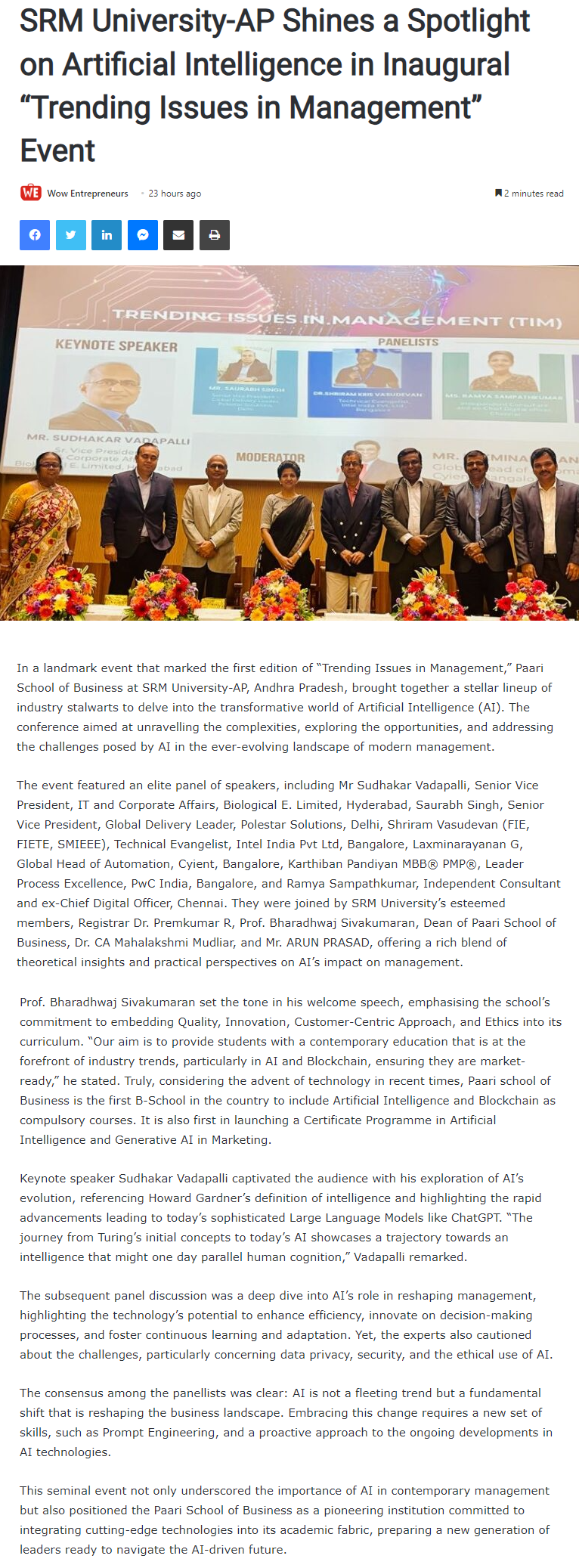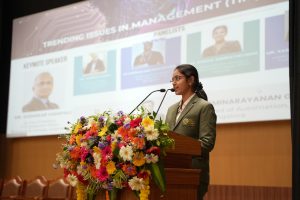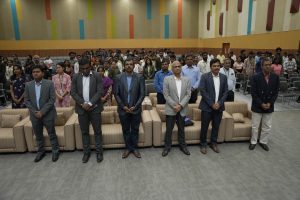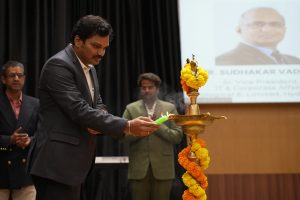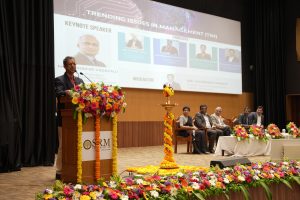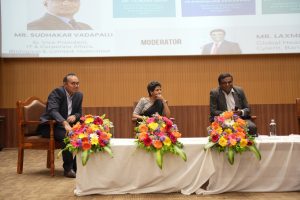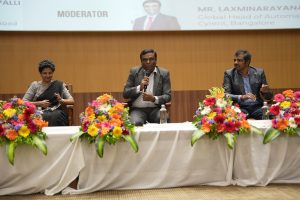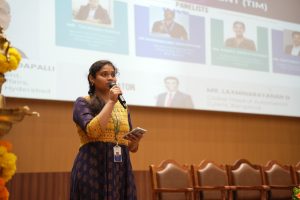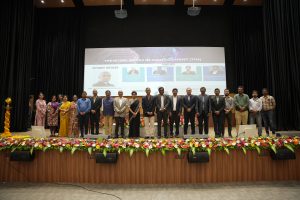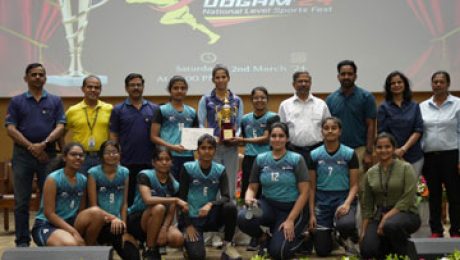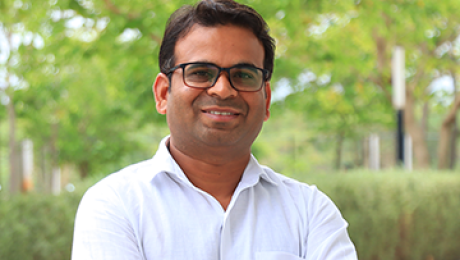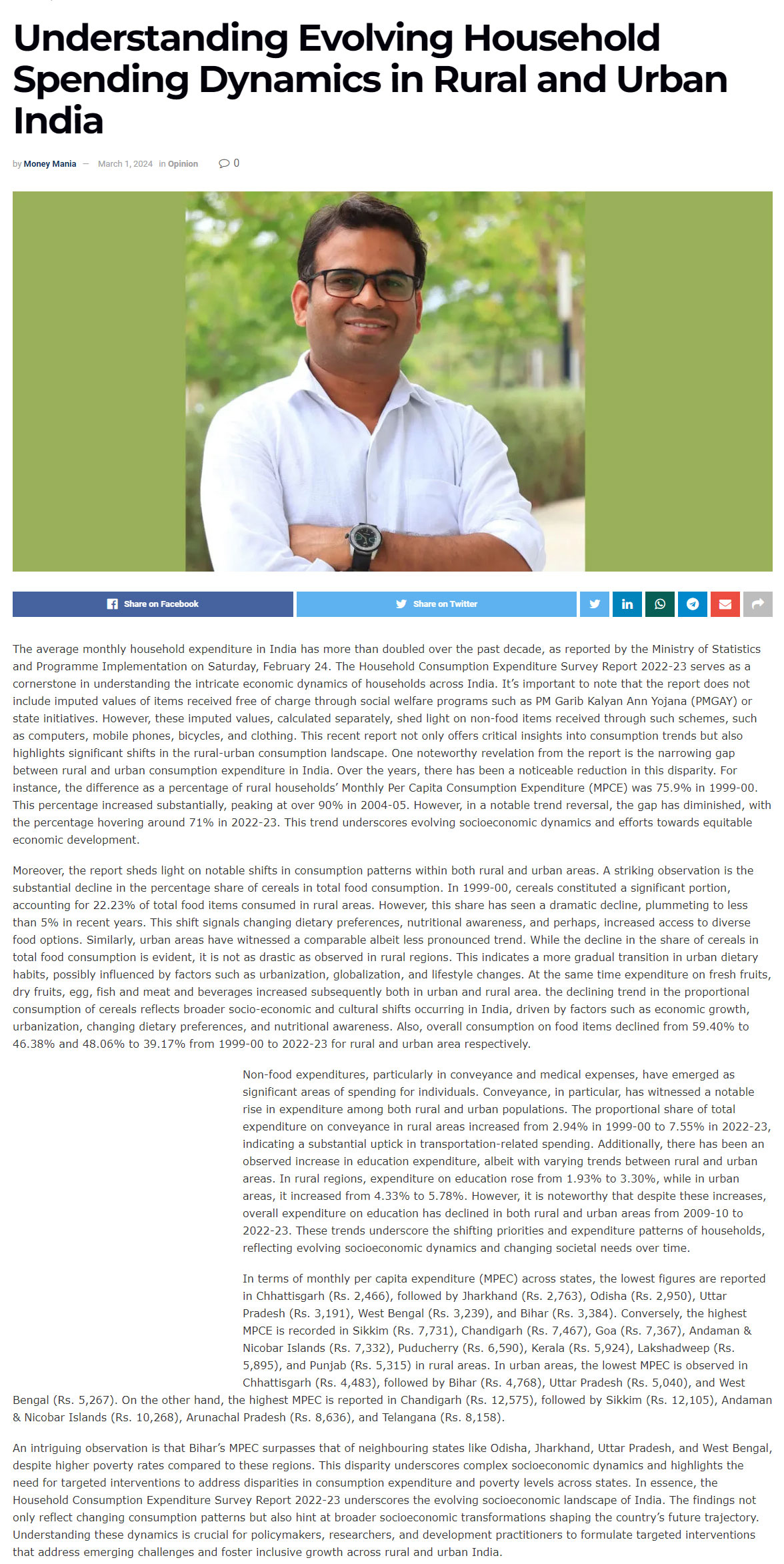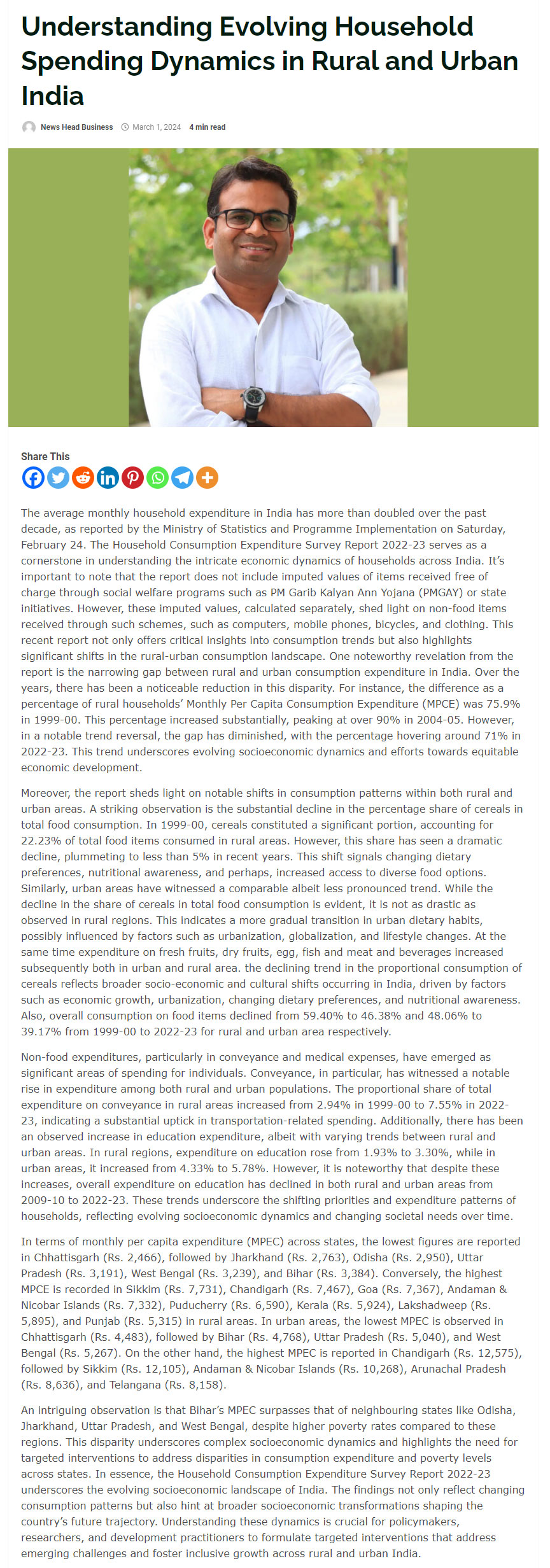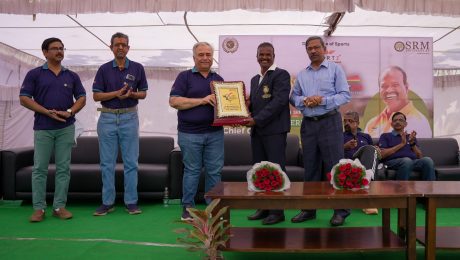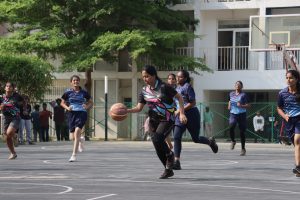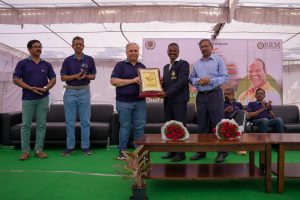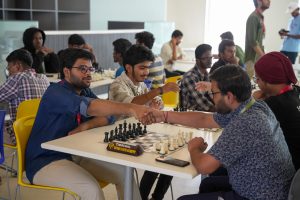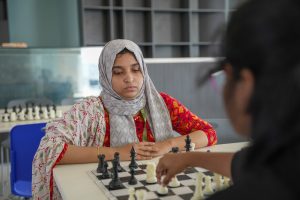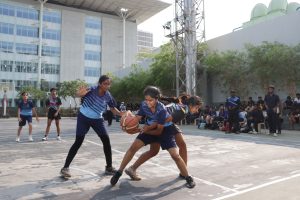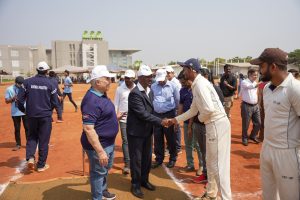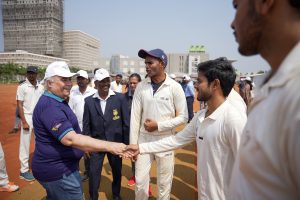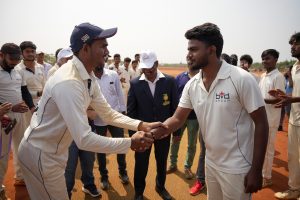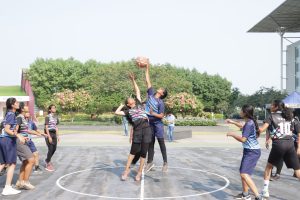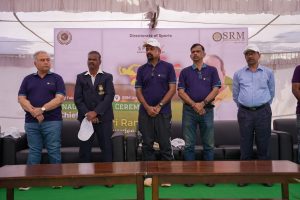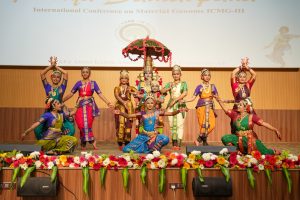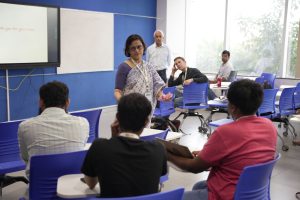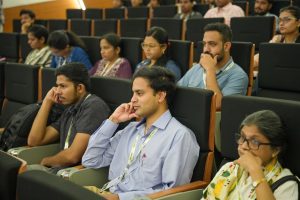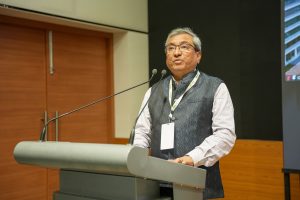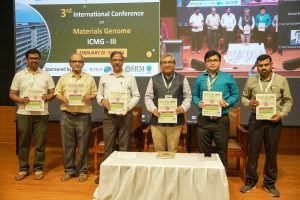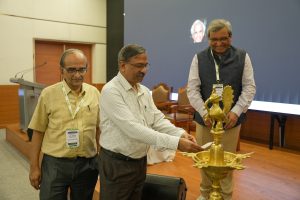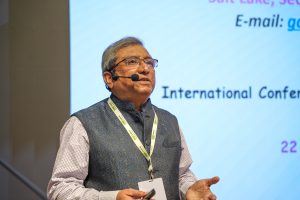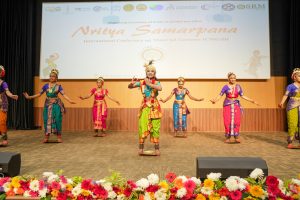Revolutionising LED Lighting: Paper Published in IEEE Transactions on Industry Applications
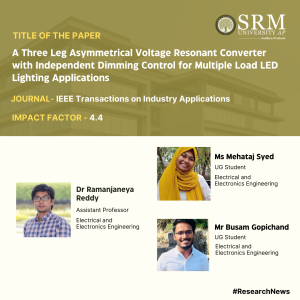 In a significant academic accomplishment, Dr Ramanjaneya Reddy, Assistant Professor in the Department of Electrical and Electronics Engineering, along with UG students Ms Mehataj Syed and Mr Busam Gopichand, have recently published a groundbreaking paper titled “A Three Leg Asymmetrical Voltage Resonant Converter with Independent Dimming Control for Multiple Load LED Lighting Applications” in the esteemed Q1 journal IEEE Transactions on Industry Applications. The journal boasts an impressive impact factor of 4.4, further underscoring the importance of this research contribution.
In a significant academic accomplishment, Dr Ramanjaneya Reddy, Assistant Professor in the Department of Electrical and Electronics Engineering, along with UG students Ms Mehataj Syed and Mr Busam Gopichand, have recently published a groundbreaking paper titled “A Three Leg Asymmetrical Voltage Resonant Converter with Independent Dimming Control for Multiple Load LED Lighting Applications” in the esteemed Q1 journal IEEE Transactions on Industry Applications. The journal boasts an impressive impact factor of 4.4, further underscoring the importance of this research contribution.
The paper delves into the development of a novel Three Leg Asymmetrical Voltage Resonant Converter that offers independent dimming control for multiple load LED lighting applications. This innovation holds great promise for enhancing the efficiency and versatility of LED lighting systems, paving the way for more sustainable and adaptable lighting solutions in various industrial applications.
Dr Ramanjaneya Reddy’s leadership and the collaborative efforts of Ms Mehataj Syed and Mr Busam Gopichand have culminated in this significant publication, which not only adds to the body of knowledge in the field but also showcases the talent and dedication of the researchers at the department.
This achievement highlights the commitment to excellence and innovation within the Department of Electrical and Electronics Engineering, positioning it as a hub for cutting-edge research and academic prowess. The impact of this research is expected to reverberate across the industry, contributing to advancements in LED lighting technology and its applications.
The publication of this paper underscores the quality and rigour of the research solidifying their reputation as leaders in the field. This accomplishment is a testament to the department’s commitment to pushing boundaries and making meaningful contributions to the field of electrical engineering.
Congratulations to Dr Ramanjaneya Reddy, Ms Mehataj Syed, and Mr Busam Gopichand on this remarkable achievement, and we look forward to seeing the continued impact of their research in the field.
Abstract
This work proposes a three-leg asymmetrical voltage resonant converter for multiple load Light Emitting Diode (LED) lighting applications. The proposed converter is developed with a common leg-1 for both load-1 and load-2. The load-1 is powered from asymmetrical voltage between leg-1 and leg-2. Similarly, load-2 is powered from asymmetrical voltage between leg-1 and leg-3. The proposed circuit provides the following major contributions: (1) Independent dimming control of LED loads; (2) Zero Voltage Switching (ZVS) of all power switches; (3) High efficiency; and (4) Asymmetrical voltage regulation. To achieve independent dimming control, the voltages between legs are made zero by dimming leg-2 and leg-3 independently. Two resonant circuits are connected in the proposed circuit. Owing to this all the power switches operate with ZVS, which reduces the switching losses. Further, two LED lamps are connected in series with battery sources to supply the threshold voltage to lamps which in turn results in a lower power processing of the converter.
Explanation of Research in Layperson’s Terms
This work proposes a three-leg asymmetrical voltage resonant converter with independent dimming control for multiple load LED lighting applications. The proposed converter drives multiple loads independently with a dimming feature. The converter is developed with leg-1 is common for both LED loads. The major contributions of the proposed LED driver are independent dimming control, asymmetrical voltage regulation, zero voltage switching of all the power switches, and high efficiency. The threshold voltage of LED loads is supplied by batteries connected in series with LED loads, which will help in lower power processing of the proposed converter. Further, due to soft switching technology implemented in this converter, it reduces the losses in the system considerably increasing efficiency.
Title of Research Paper in the Citation Format
A Three Leg Asymmetrical Voltage Resonant Converter with Independent Dimming Control for Multiple Load LED Lighting Applications.
Citation: Ramanjaneya Reddy Udumula, et. al, “A Three Leg Asymmetrical Voltage Resonant Converter with Independent Dimming Control for Multiple Load LED Lighting Applications,” IEEE Transactions on Industry Applications, Feb 2024. doi: 10.1109/TIA.2024.3363676
Practical and Social Implementation of Research
To achieve effective and efficient use of energy resources under the sustainable development goals, Light Emitting Diodes (LEDs) have emerged as a global lighting industry solution. Over the conventional lighting sources such as incandescent lamps, fluorescent lamps, and high intensity discharge lamps, LEDs are i) more efficient, ii) eco-friendly due to absence of toxic gases, iii) have longer life span up to one lakh year, iv) high luminous intensity and v) good colour rendering index. LED’s requires low voltage direct current supply and the V-I characteristics of LEDs which is like Shockley diode represents the exponential growth of current over a small voltage variation which may damage the LED or effects the illumination. Hence, an LED driver is necessary in an LED system to supply LEDs with constant current. DC fed LED drivers are more reliable due to absence of AC-DC conversion stage and power factor correction stage which are crucial in AC fed LED drivers. Therefore, DC fed LED drivers are paid more attention in recent times in the majority of battery-powered/solar-powered applications. Given its features of high power, exceptional efficiency, cost-effectiveness, and flicker-free operation, this innovation is well-suited for streetlight/stadium lighting applications.
Collaborations
Dr. Kasi Ramakrishna Reddy, Assistant Professor
Department of Electrical and Electronics Engineering, Vasavi College of Engineering, Hyderabad
Future Research Plans
The future work is on PV/battery fed LED driver topologies suitable for streetlighting/stadium lighting applications with low component count, high efficiency, reduced device stress, and flicker free lighting system
- Published in Departmental News, EEE NEWS, News, Research News
Unveiling Literary Insights on Salman Rushdie’s The Moor’s Last Sigh
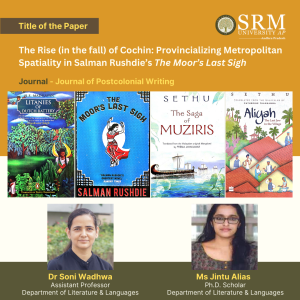 In a remarkable achievement, Dr Soni Wadhwa, Assistant Professor in the Department of Literature and Languages at SRM University-AP, and Ms Jintu Alias, a PhD Scholar, have made a significant contribution to the field of postcolonial studies with their paper titled “The rise (in the fall) of Cochin: Provincializing metropolitan spatiality in Salman Rushdie’s The Moor’s Last Sigh.”
In a remarkable achievement, Dr Soni Wadhwa, Assistant Professor in the Department of Literature and Languages at SRM University-AP, and Ms Jintu Alias, a PhD Scholar, have made a significant contribution to the field of postcolonial studies with their paper titled “The rise (in the fall) of Cochin: Provincializing metropolitan spatiality in Salman Rushdie’s The Moor’s Last Sigh.”
The paper, published in the highly esteemed Journal of Postcolonial Writing offering a fresh perspective on Salman Rushdie’s acclaimed novel, “The Moor’s Last Sigh.” Through their insightful analysis, Dr Wadhwa and Alias challenge the conventional notions of metropolitan spatiality and provide a nuanced understanding of the provincial city of Cochin.
Dr Soni Wadhwa and Jintu Alias, a promising PhD Scholar, have meticulously analysed Rushdie’s The Moor’s Last Sigh, shedding light on the complex dynamics of metropolitan spatiality and the rise and fall of Cochin within the narrative.
Their research explores Rushdie’s portrayal of Cochin, challenging traditional notions of metropolitan spaces and offering a fresh perspective on the provincial nation of such spatialities. This groundbreaking analysis delves deep into the layers of cultural, historical, and socio-political contexts within Rushdie’s work, showcasing the authors’ keen insights and critical thinking.
The publication of this paper highlights the invaluable contributions of our faculty and scholars in the field of literature and postcolonial studies. It is a testament to the rigorous academic environment and the commitment to excellence fostered at SRM University-AP.
We extend our warmest congratulations to Dr Soni Wadhwa and Jintu Alias for their remarkable achievement. Their dedication to research and passion for exploring the nuances of literature continue to inspire us all.
Explanation of the Research in Layperson’s Terms
Bombay/Mumbai is a great city widely celebrated in literature, especially for its cosmopolitanism. Salman Rushdie’s novel The Moor’s Last Sigh has been read by various critics for the richness of the portrayal of Mumbai. In their research, PhD scholar Jintu Alias and her PhD supervisor Dr Soni Wadhwa have analysed the representation of Cochin in the novel. Regarding their research they say, “For very long, Cochin’s presence has been eclipsed by that of Mumbai. But there is more to the novel than Bombay’s history. Like any art or literature, this novel is open to multiple interpretations. Our study is focused on the depiction of space in postcolonial literature with a focus on the island city Cochin in Kerala. When we immersed ourselves into the novel, we found that its charm is irresistible. Rushdie primarily opened a new city for other writers to explore. This novel was followed by several more novels that took an even closer look at the history of Cochin (now Kochi).”
Abstract
Indian fiction and critical engagements with it have a metropolitan bias. The preference for representations of big cities such as Mumbai in fiction means that non-metropolitan (“provincial”) spaces in India face neglect, literary and otherwise. This article argues for provincialising Indian fiction by exploring non-metropolitan locations as imagined in works of fiction to unpack alternative spatiality. The example offered is Salman Rushdie’s The Moor’s Last Sigh. In most readings of the novel, Bombay (along with Moorish Spain) is highlighted as a metropolitan model for India. Cochin does not figure in these readings, which are passed over as if just a random background or setting for the characters to be launched into Mumbai. This article addresses Cochin’s marginalisation by investigating how the island city offers a provincial, alternative, non-metropolitan theorisation of spatialities in Indian fiction. The larger objective is to make space for similarly marginalised non-European locales in the discourse of cosmopolitanism.
Social Implications
- We hope that with this interpretation of the novel from the point of view of Cochin and its history and cosmopolitanism, smaller cities in India get more attention from literary critics.
- We also hope that our research excites further studies and creative writing on other aspects of cultural traditions practised in smaller cities in India. There are many more themes and historical and geographical settings to explore in Indian literature!
Future Research
In continuation of our method of reading different Kochi texts, we will engage with more novels in the future. Our previous reading of another Kochi novel was published in Modern Jewish Studies in September 2023. We look forward to strengthening this body of work in the future.
About This Collaboration
PhD scholar Ms Jintu Alias and Assistant Professor Dr Soni Wadhwa have been working on this area of the Kochi novel since May 2021. This has been an exciting spatiality project in the context of Indian literature.
Citation
Alias, J., & Wadhwa, S. (2024). The rise (in the fall) of Cochin: Provincializing metropolitan spatiality in Salman Rushdie’s The Moor’s Last Sigh. Journal of Postcolonial Writing, 1-13. https://doi.org/10.1080/17449855.2024.2307408
- Published in Departmental News, English Current Happenings, News, Research News
SRM University-AP Shines a Spotlight on Artificial Intelligence in Inaugural “Trending Issues in Management” Event
- Published in Newsroom
PSB Hosts First Edition of Trending Issues in Management with Focus on AI
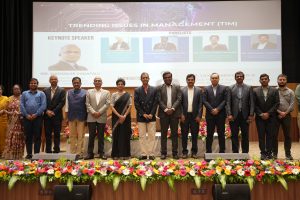 In a landmark event that marked the first edition of “Trending Issues in Management,” Paari School of Business at SRM University-AP brought together a stellar lineup of industry stalwarts to delve into the transformative world of Artificial Intelligence (AI). The conference aimed at unravelling the complexities, exploring the opportunities, and addressing the challenges posed by AI in the ever-evolving landscape of modern management.
In a landmark event that marked the first edition of “Trending Issues in Management,” Paari School of Business at SRM University-AP brought together a stellar lineup of industry stalwarts to delve into the transformative world of Artificial Intelligence (AI). The conference aimed at unravelling the complexities, exploring the opportunities, and addressing the challenges posed by AI in the ever-evolving landscape of modern management.
The event featured an elite panel of speakers, including Mr Sudhakar Vadapalli, Senior Vice President IT and Corporate Affairs, Biological E. Limited, Hyderabad, Saurabh Singh, Senior Vice President, Global Delivery Leader, Polestar Solutions, Delhi, Shriram Vasudevan (FIE, FIETE, SMIEEE), Technical Evangelist, Intel India Pvt Ltd, Bangalore, Laxminarayanan G, Global Head of Automation, Cyient, Bangalore, Karthiban Pandiyan MBB® PMP®, Leader Process Excellence, PwC India, Bangalore, and Ramya Sampathkumar, Independent Consultant and ex-Chief Digital Officer, Chennai.
They were joined by SRM AP’s esteemed members, Dr R Premkumar, Registrar, Prof. Bharadhwaj Sivakumaran, Dean of Paari School of Business, Dr CA Mahalakshmi Mudliar, and Mr Arun Prasad, offering a rich blend of theoretical insights and practical perspectives on AI’s impact on management.
Prof. Bharadhwaj Sivakumaran set the tone in his welcome speech, emphasising the school’s commitment to embedding Quality, Innovation, Customer-Centric Approach, and Ethics into its curriculum. “Our aim is to provide students with a contemporary education that is at the forefront of industry trends, particularly in AI and Blockchain, ensuring they are market-ready,” he stated.
Truly, considering the advent of technology in recent times, Paari school of Business is the first B-School in the country to include Artificial Intelligence and Blockchain as compulsory courses. It is also first in launching a Certificate Programme in Artificial Intelligence and Generative AI in Marketing.
Keynote speaker Sudhakar Vadapalli captivated the audience with his exploration of AI’s evolution, referencing Howard Gardner’s definition of intelligence and highlighting the rapid advancements leading to today’s sophisticated Large Language Models like ChatGPT. “The journey from Turing’s initial concepts to today’s AI showcases a trajectory towards an intelligence that might one day parallel human cognition,” Vadapalli remarked.
The subsequent panel discussion was a deep dive into AI’s role in reshaping management, highlighting the technology’s potential to enhance efficiency, innovate decision-making processes, and foster continuous learning and adaptation. Yet, the experts also cautioned about the challenges, particularly concerning data privacy, security, and the ethical use of AI.
The consensus among the panellists was clear: AI is not a fleeting trend but a fundamental shift reshaping the business landscape. Embracing this change requires new skills, such as Prompt Engineering and a proactive approach to the ongoing developments in AI technologies.
This seminal event underscored the importance of AI in contemporary management and positioned the Paari School of Business as a pioneering institution committed to integrating cutting-edge technologies into its academic fabric, preparing a new generation of leaders ready to navigate the AI-driven future.
- Published in Departmental News, News, Paari Current Happenings
SRM University-AP Successfully Hosts Udgam-24, Celebrating National Sportsmanship
The Hindu

The New Indian Express
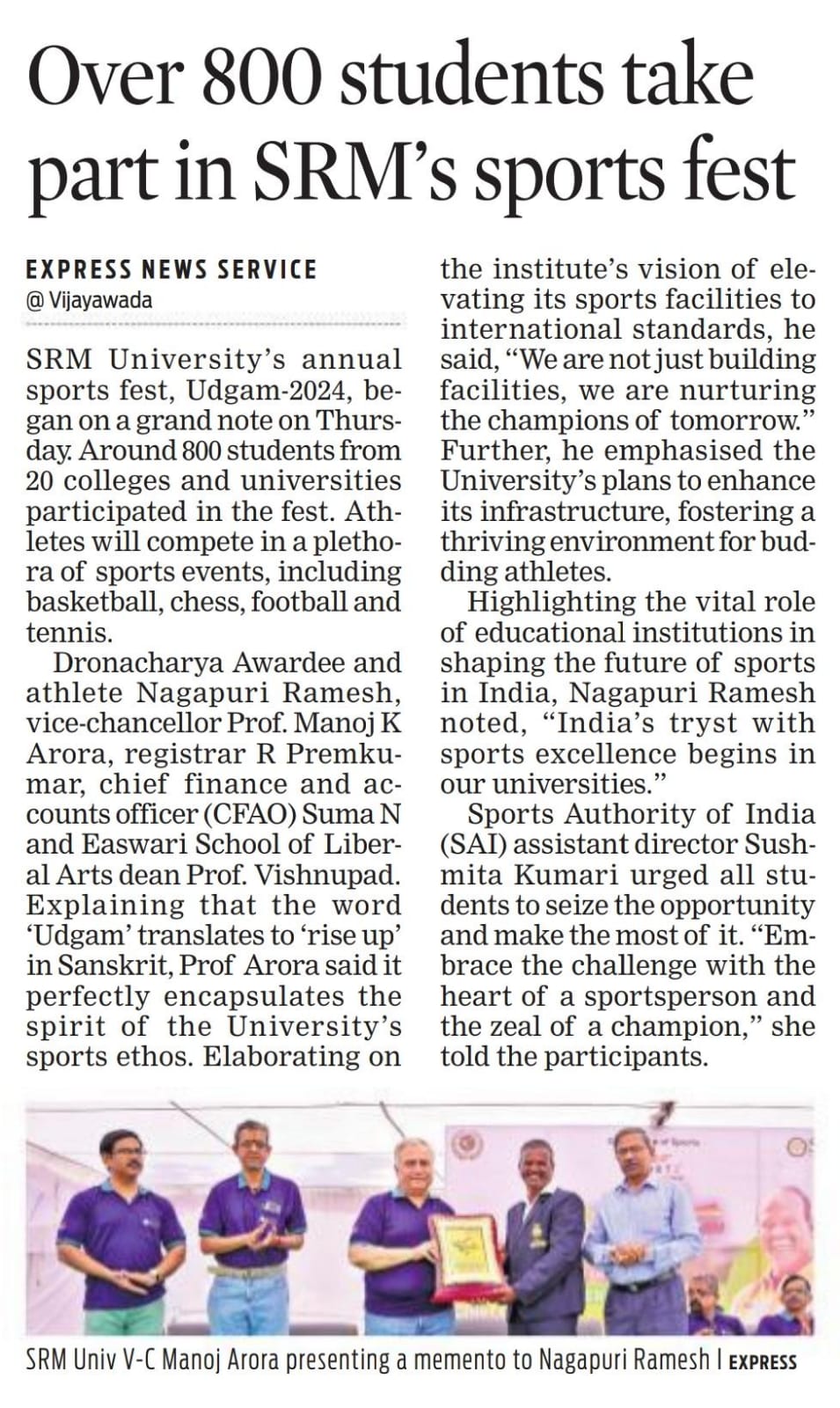
The Deccan Chronicle
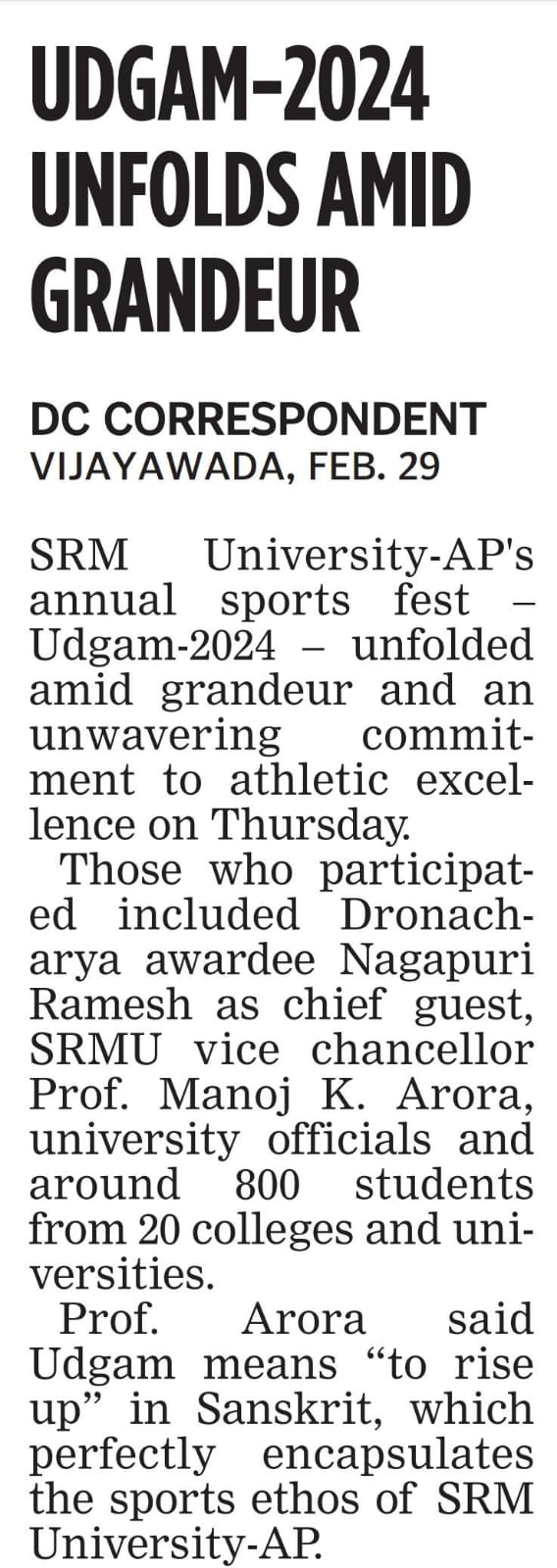
The Pioneer
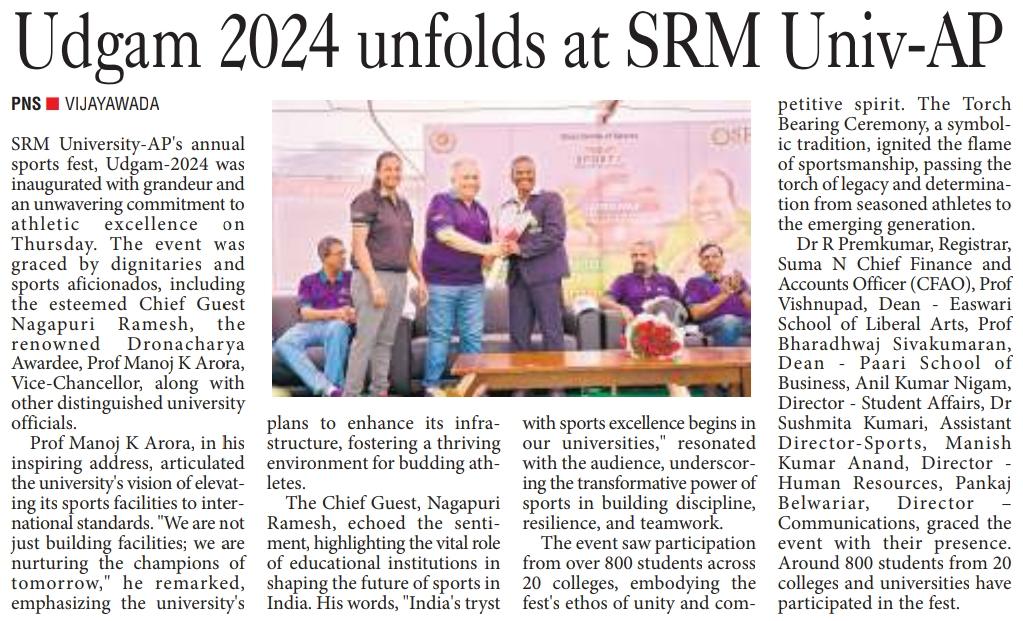
The Hans India
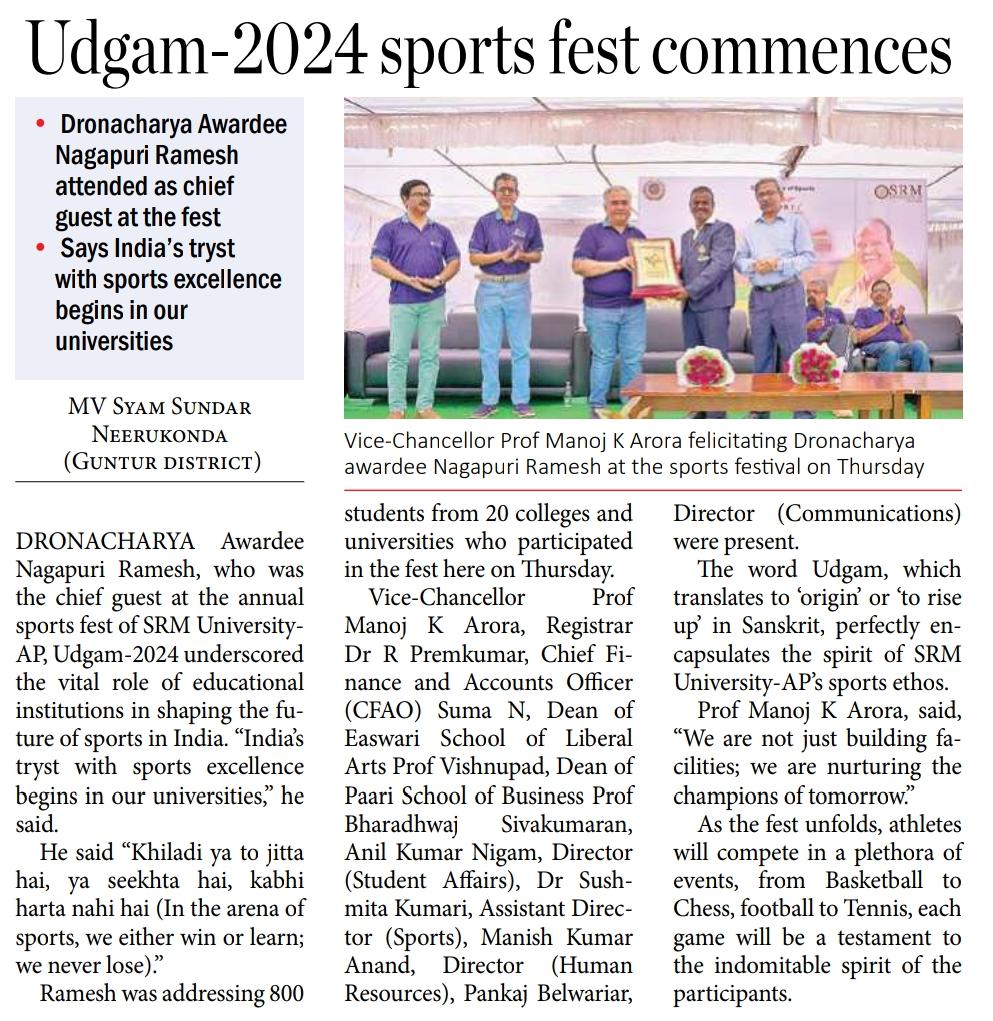
Andhra Patrika
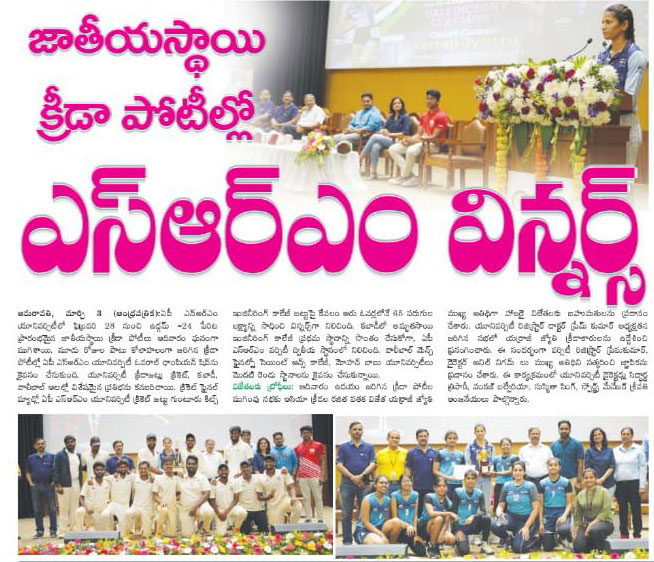
Andhra Prabha
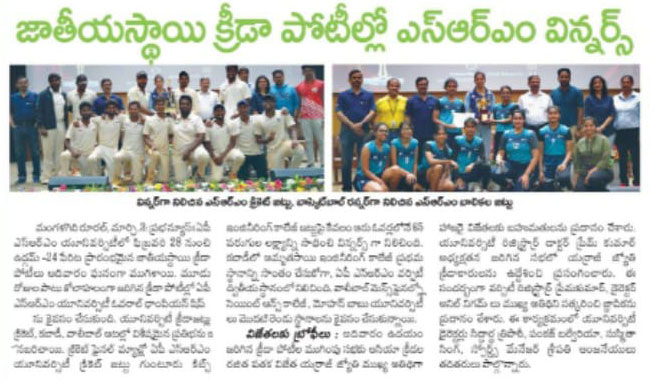
Eenadu
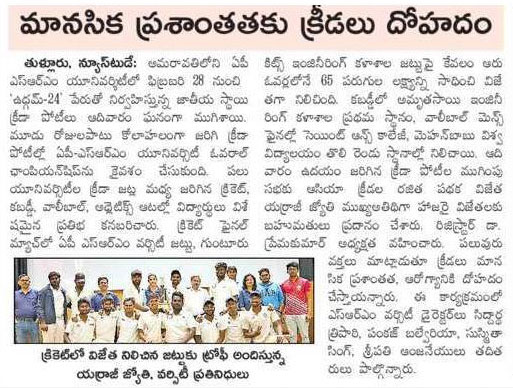
Surya
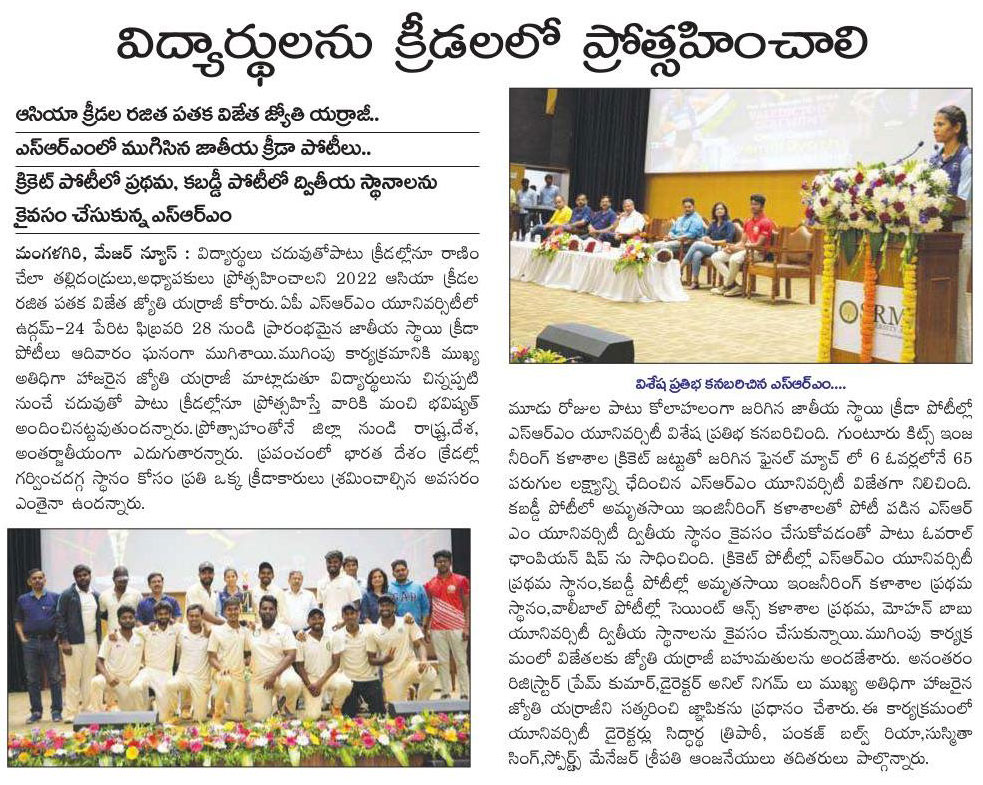
Vartha
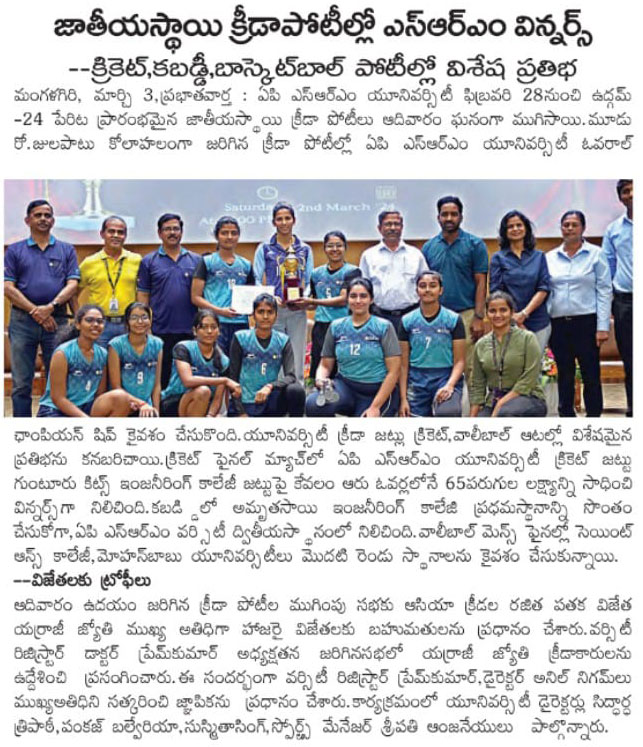
Visalaandhra
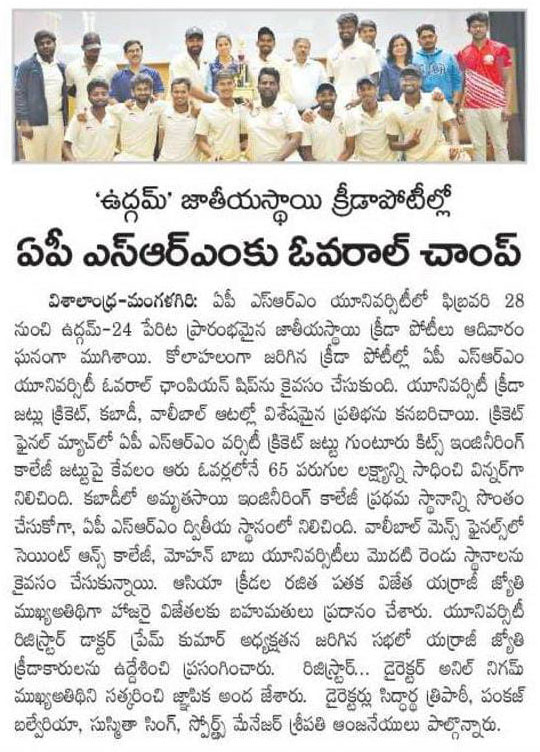
- Published in Newsroom
Understanding Evolving Household Spending Dynamics in Rural and Urban India
- Published in Thought Leadership
UDGAM 2024 unfolds amid grandeur
Deccan Chronicle
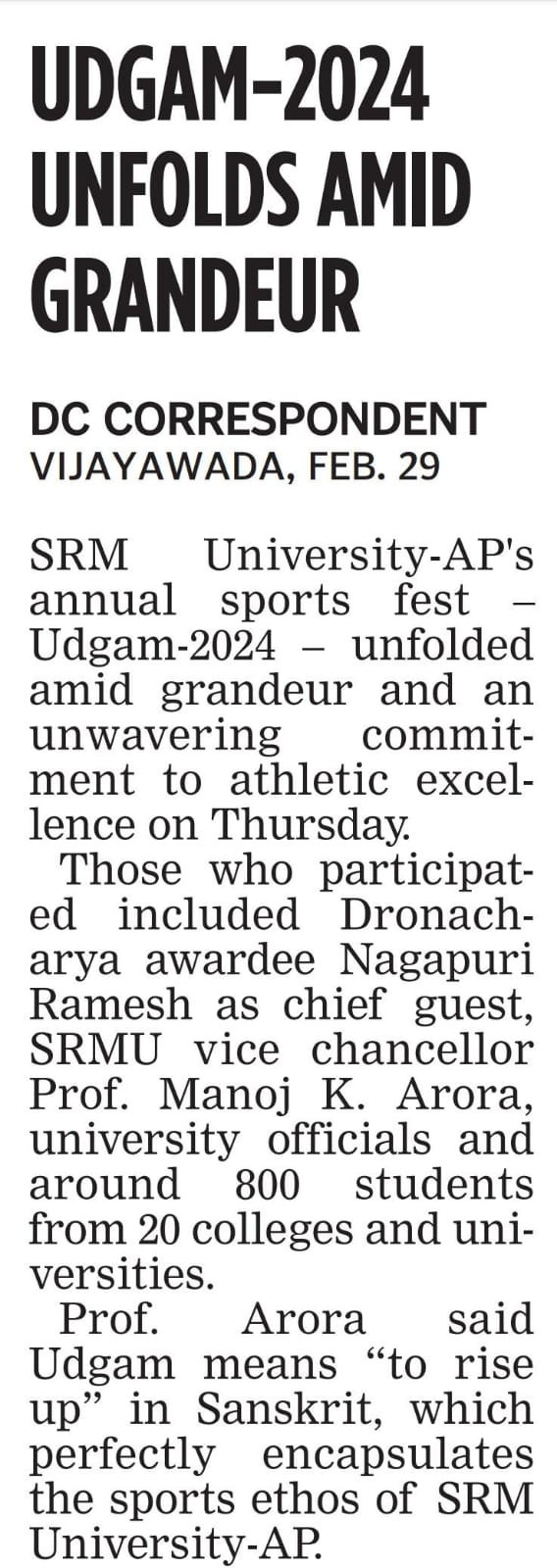
The Pioneer
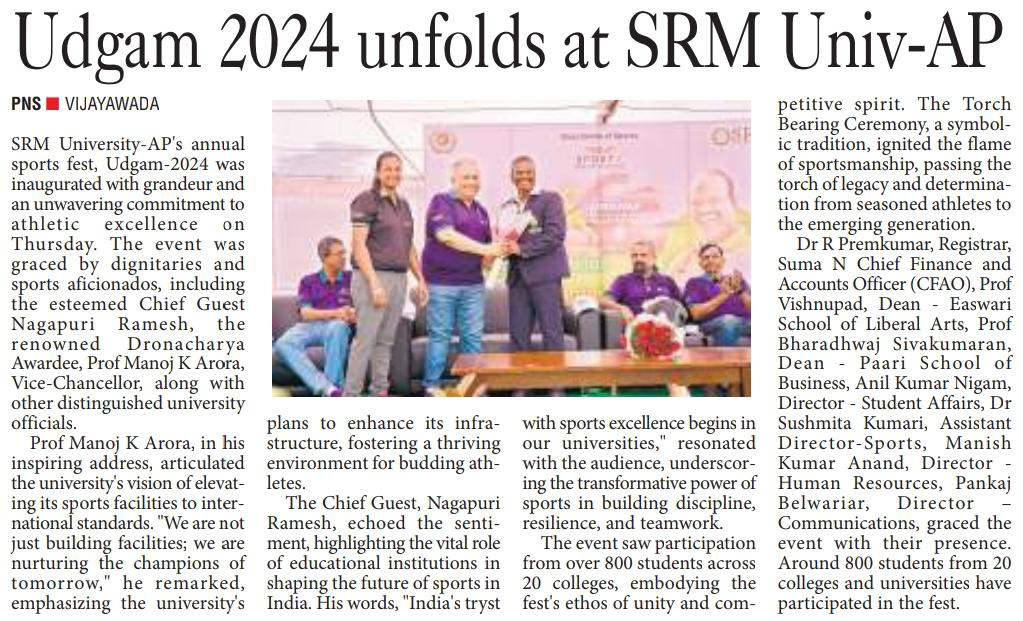
The Hindu

The New Indian Express
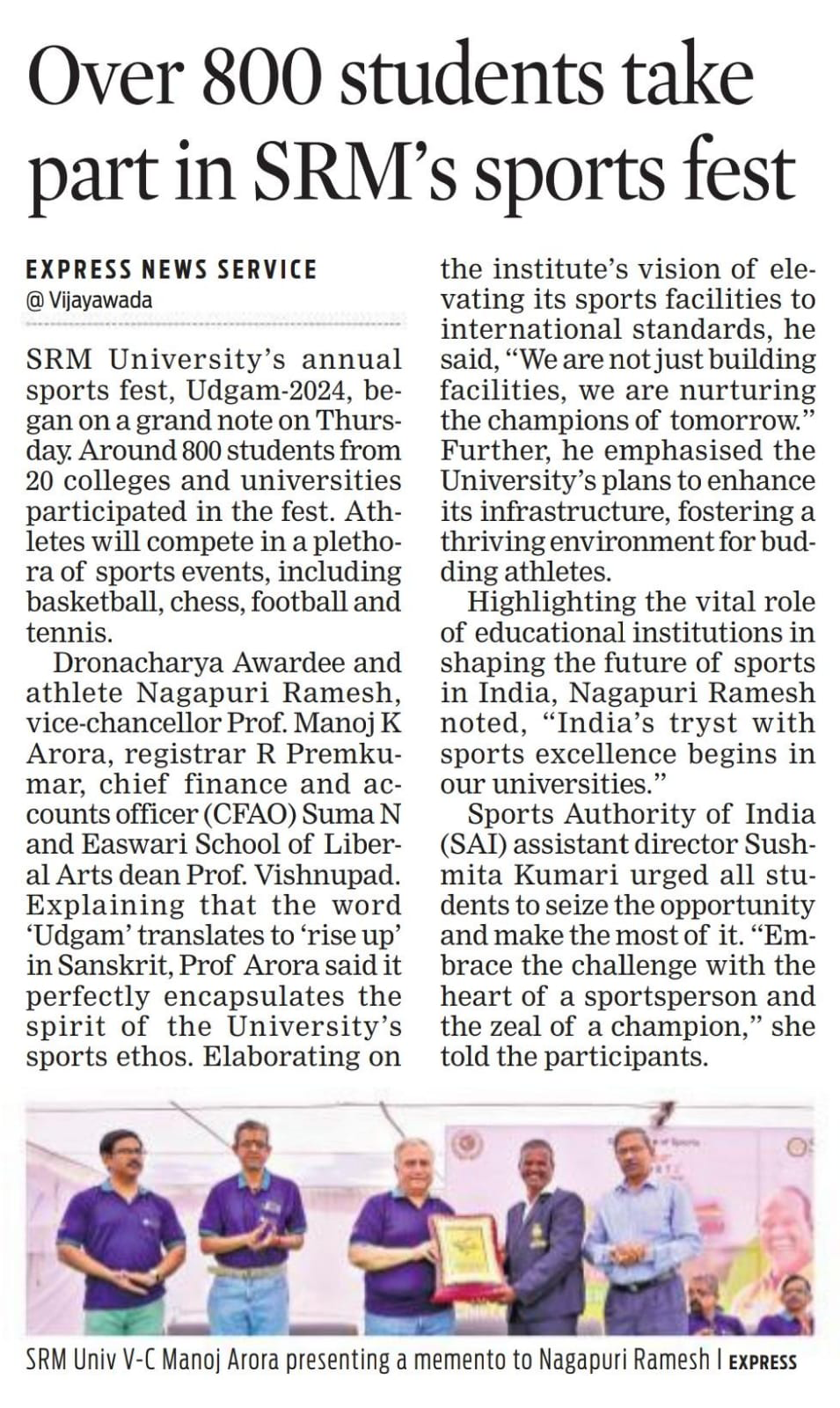
Telugu Patrika
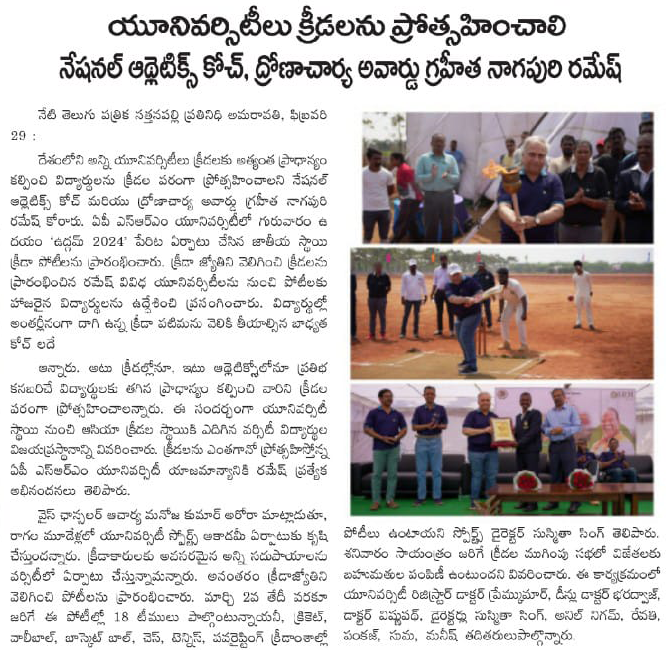
Surya
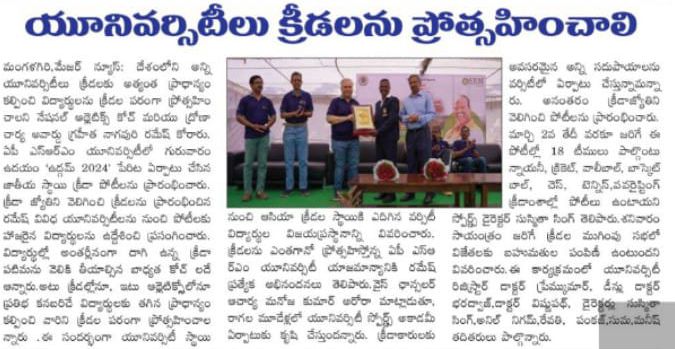
Praja Sakthi
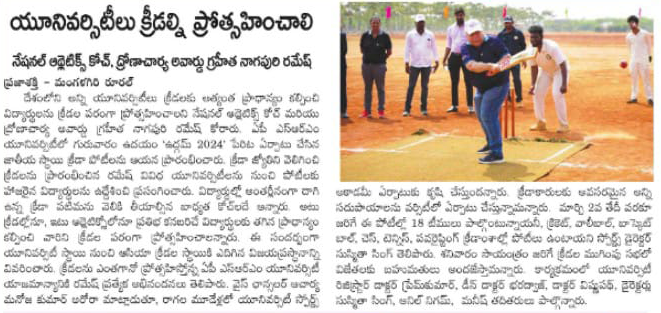
Eenadu
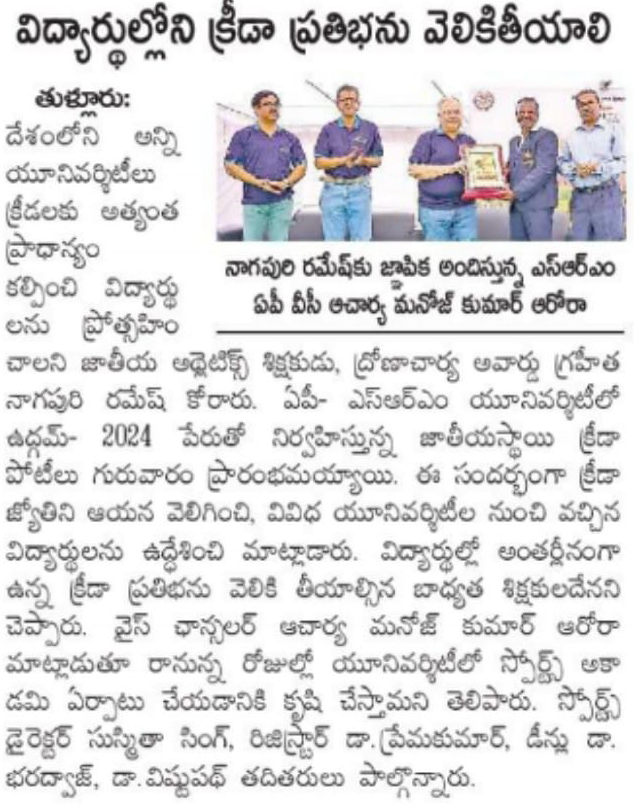
Andhra Prabha
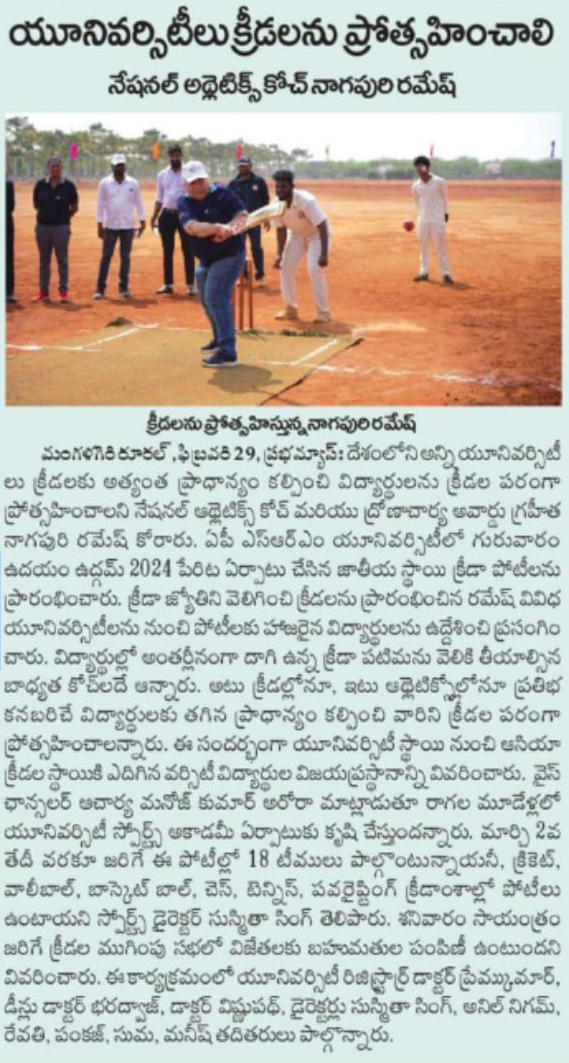
Andhra Patrika
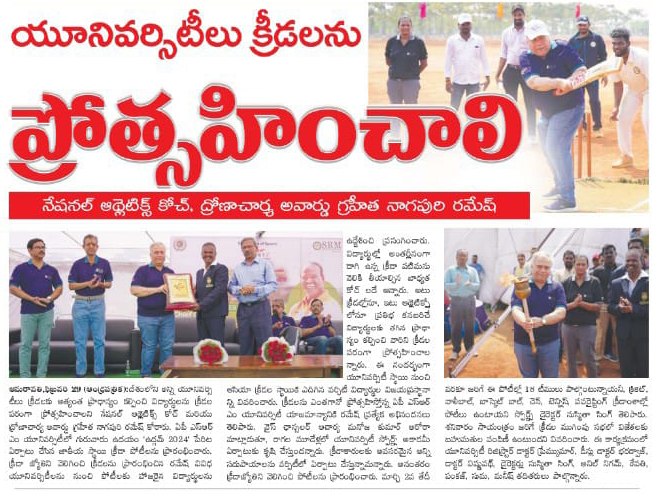
- Published in Newsroom
Udgam 2024 – A Celebration of Sportsmanship and Excellence
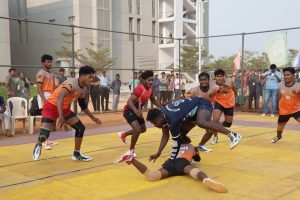 In a magnificent celebration of sports and camaraderie, SRM University-AP’s annual sports fest, Udgam-2024, unfolded with grandeur and an unwavering commitment to athletic excellence on February 29, 2024. The event was graced by dignitaries and sports aficionados, including the esteemed Chief Guest Mr. Nagapuri Ramesh, the renowned Dronacharya Awardee, Prof. Manoj K. Arora, Vice-Chancellor, along with other distinguished university officials, Dr R Premkumar, Registrar, Mrs Suma N, Chief Finance and Accounts Officer (CFAO), Prof. Vishnupad, Dean – Easwari School of Liberal Arts, Prof. Bharadhwaj Sivakumaran, Dean – Paari School of Business, Mr Anil Kumar Nigam, Director – Student Affairs, Dr. Sushmita Kumari, Assistant Director-Sports, Mr Manish Kumar Anand, Director – Human Resources, Mr Pankaj Belwariar, Director – Communications, graced the event with their presence. Around 800 students from 20 colleges and universities have participated in the fest.
In a magnificent celebration of sports and camaraderie, SRM University-AP’s annual sports fest, Udgam-2024, unfolded with grandeur and an unwavering commitment to athletic excellence on February 29, 2024. The event was graced by dignitaries and sports aficionados, including the esteemed Chief Guest Mr. Nagapuri Ramesh, the renowned Dronacharya Awardee, Prof. Manoj K. Arora, Vice-Chancellor, along with other distinguished university officials, Dr R Premkumar, Registrar, Mrs Suma N, Chief Finance and Accounts Officer (CFAO), Prof. Vishnupad, Dean – Easwari School of Liberal Arts, Prof. Bharadhwaj Sivakumaran, Dean – Paari School of Business, Mr Anil Kumar Nigam, Director – Student Affairs, Dr. Sushmita Kumari, Assistant Director-Sports, Mr Manish Kumar Anand, Director – Human Resources, Mr Pankaj Belwariar, Director – Communications, graced the event with their presence. Around 800 students from 20 colleges and universities have participated in the fest.
The word ‘UDGAM’, which translates to ‘origin’ or ‘to rise up’ in Sanskrit, perfectly encapsulates the spirit of SRM AP’s sports ethos. Not merely an extracurricular activity, sports at SRM University-AP are embraced as a pivotal element of student life, reflecting a holistic approach to education and personal development.
Prof. Manoj K Arora, in his inspiring address, articulated the university’s vision of elevating its sports facilities to international standards. “We are not just building facilities; we are nurturing the champions of tomorrow,” he remarked, emphasising the university’s plans to enhance its infrastructure, fostering a thriving environment for budding athletes.
The Chief Guest, Mr Nagapuri Ramesh, echoed the sentiment, highlighting the vital role of educational institutions in shaping the future of sports in India. His words, “India’s tryst with sports excellence begins in our universities,” resonated with the audience, underscoring the transformative power of sports in building discipline, resilience, and teamwork.
The event saw participation from over 800 students across 20 colleges from all over India, embodying the fest’s ethos of unity and competitive spirit. The Torch Bearing Ceremony, a symbolic tradition, ignited the flame of sportsmanship, passing the torch of legacy and determination from seasoned athletes to the emerging generation.
“I’m immensely grateful to the university management for granting me this incredible opportunity. Witnessing the spirited and joyous participation of the students fills us with exhilaration. SRM University-AP has truly set the stage for these young athletes to hone essential life skills such as leadership and team building. I urge all students to seize this momentous opportunity with both hands and make the most of it, embracing the challenge with the heart of a sportsperson and the zeal of a champion,” said Dr Sushmita Kumari, Assistant Director-Sports.
As the fest unfolds, athletes will compete in a plethora of events, from Basketball to Chess, football to Tennis, each game would be a testament to the indomitable spirit of the participants. The fest was not just a competition but a celebration of the enduring values that sports instil – teamwork, integrity, and the pursuit of excellence.
In conclusion, Udgam 2024 stands as a symbol of inspiration, urging students to embrace the spirit of sportsmanship, to learn from every game, and to always play with heart and honor. As Mr Ramesh poignantly stated, “Khiladi ya to jitta hai, ya sikhta hai, kavi harta nahi hai (In the arena of sports, we either win or learn; we never lose).”
- Published in News, Sports News, student affairs news
3rd ICMG Inauguration: Emerging Interfaces in Materials Genome
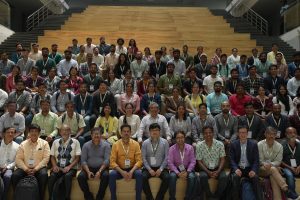 The third chapter of the biennial International Conference on Materials Genome (ICMG) was inaugurated at SRM University-AP, India on February 22, 2024, in the august presence of Prof G P Das, Research Institute for Sustainable Energy, India, Prof Yoshiyuki Kawazoe, Tohoku University, Japan, Prof Puru Jena, Virginia Commonwealth University, USA, Prof Jer Lai Kuo, Dr R Premkumar, Registrar, SRM University AP, Prof Ranjit Thapa, Dean-Research, Dr Pranab Mandal, Associate Professor & Head of the Department, Physics, Dr Mahesh Ravva, Associate Professor, Chemistry, Dr Pradyut Kumar Sanki, Associate Professor, Electronics and Communication Engineering and 150+ dignitaries across the world.
The third chapter of the biennial International Conference on Materials Genome (ICMG) was inaugurated at SRM University-AP, India on February 22, 2024, in the august presence of Prof G P Das, Research Institute for Sustainable Energy, India, Prof Yoshiyuki Kawazoe, Tohoku University, Japan, Prof Puru Jena, Virginia Commonwealth University, USA, Prof Jer Lai Kuo, Dr R Premkumar, Registrar, SRM University AP, Prof Ranjit Thapa, Dean-Research, Dr Pranab Mandal, Associate Professor & Head of the Department, Physics, Dr Mahesh Ravva, Associate Professor, Chemistry, Dr Pradyut Kumar Sanki, Associate Professor, Electronics and Communication Engineering and 150+ dignitaries across the world.
ICMG is set up to nurture and promote research and development activities in computational materials in association with Asian Consortium on Computational Materials Science (ACCMS), Jawaharlal Nehru Centre for Advanced Scientific Research, Bangalore (JNCASR), National Chemical Laboratory, Pune (NCL), Virginia Commonwealth University, USA, Indian Institute of Technology, Madras (IIT-M), Indian Institute of Technology, Bombay (IIT-B), TCG-Crest, Kolkata.
In his inaugural speech, Dr R Premkumar delved into the vision of SRM University-AP as a new-age research-centric university. Within 7 years of inception, SRM University-AP proudly harbours 20 departments across 3 schools, providing education to 8500 students. The university aspires to bring quality education to 15000 students in the near future. The research environment of the university is no less than excellent. The university strives to contribute to society through outstanding research activities. The premier faculty pool of the university with 100% PhD and international academic and industry exposure and the zeal to do quality research makes it a chosen haven for achievers. SRM University-AP supports its faculty and students in research by providing Seed Funding, Research Grants, Financial Assistance for Publications and Patents, Conference Aids and state-of-the-art research facilities. “The university’s mission is to create a newer generation who could substantially contribute to the academia and industry. Hence, we encourage our students with equal importance to take entrepreneurship, higher studies and/or Placement support as their future endeavours”, said Dr R Premkumar.
In his keynote speech, Prof. G P Das congratulated the University for the successful arrangement of the 3rd International Conference on Materials Genome. In the year 2000, the Asian consortium was born from a tea table discussion and has come a long way since. This consortium has become 25 years old, and they have been utilizing human as well as computational resources in different countries in the Asian region. The year 2024 marks the 60th year of the two most important milestone developments in the field of materials simulation – (i) Density Functional Theory by Walter Kohn and (ii) the landmark paper by Aneesur Rahman who is considered the founding father of computer simulation and molecular dynamics. It is exciting to note how the research in this domain has evolved in the years between. “One of the most recent additions to this is the marriage between materials science and computer science. This is also termed materials informatics or materials genomics. Big data, deep neural networks, reinforcement learning etc. are becoming more and more familiar tools for materials physicists and chemists. An increasingly large number of papers are appearing in the most prestigious peer-reviewed journals on the data-centric approach to discover as well as predict novel energy materials, catalytic materials, magnetic & spintronic materials, various kinds of functional materials and more recently topological materials,” asserted Prof Das.
Prof. Das further emphasised that there are a large number of areas that are being investigated with the aid of modern technologies like AI-ML. For example, the space group of a complex geological sample can be predicted just by looking at its X-ray or Neutron diffraction data using deep neural networks which was conventionally used to be done by Rietveld analysis, but now such inverse problems can be dealt with AI-ML. Such data-centric pattern-recognition approaches and their triumphs in predicting the behaviour of hitherto unknown areas e.g. cryptography, agriculture, and even criminology open up a bright new future ahead of us. Prof. Das concluded his speech by reminding us that we are now far ahead of our conventional ways of studying. The emerging ‘interface areas’ between disciplines such as biology and physics, economics & physics, metallurgy & physics, electronics & physics, mathematics & statistics, and many other suggests an enormous leap in computational approaches with advances in experimental measurements.
The Sub-themes of the conference for this year are Quantum Mechanics/Machine Learning Approach, High-throughput Computation and Machine Learning aided discovery of Materials, on which 6 keynote speeches and 46 invited lectures will be delivered in the coming 3 days. It is indeed heartening to see the conglomeration of so many stalwarts covering broad areas in Physics, Chemistry and Materials Science.
- Published in Departmental News, News, Physics News


